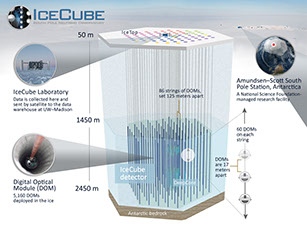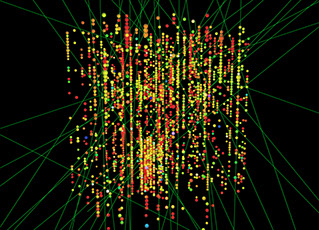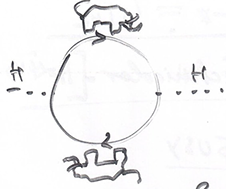Neutrino Interferometry for High-Precision Tests of Lorentz Symmetry with IceCube
IceCube Collaboration
preprint@arXiv:1709.03434
High-energy neutrino attenuation in the Earth and its associated uncertainties
A. C. Vincent (UCL), C.A. Argüelles (MIT), and A. Kheirandish (UW-Madison)
Submitted to JCAP, preprint@arXiv:1706.09895
Solar Atmospheric Neutrinos and the Sensitivity Floor for Solar Dark Matter Annihilation Searches
C.A. Argüelles (MIT), G. de Wasseige (VUB), A. Fedynitchc (KIT), and B.J.P. Jones (UTA)
JCAP 1707 (2017) no.07, 024, preprint@arXiv:1703.07798.
Imaging Galactic Dark Matter with High-Energy Cosmic Neutrinos
C.A. Argüelles (MIT), A. Kheirandish (UW-Madison), and A. C. Vincent (UCL)
Phys. Rev. Lett. (2017), preprint@arXiv:1703.00451.
First Constraints on the Complete Neutrino Mixing Matrix with a Sterile Neutrino
G.H. Collin (MIT), C.A. Argüelles (MIT), J.M. Conrad (MIT), and M.H. Shaevitz (Columbia)
Phys. Rev. Lett. 117, 221801 (2016). (arXiv:1607.00011).
Searches for Sterile Neutrinos with the IceCube Detector
IceCube Collaboration
Phys. Rev. Lett. 117 071801. (arXiv:1605.01990).
Production of keV Sterile Neutrinos in Supernovae: New Constraints and Gamma Ray Observables
C.A. Argüelles (MIT), V. Brdar (Mainz University), and J. Kopp (Mainz University)
preprint@arXiv:1505.00654.
Dark Gauge Bosons: LHC Signatures of Non-Abelian Kinetic Mixing
C.A. Argüelles (UW-Madison, MIT), X.-G. He (Shangahai Jiaotong Univ.), G. Ovanesyan (UMass.-Amherst), T. Peng (UW-Madison), and M. Ramsey-Musolf(Mass.-Amherst)
PLB (arXiv:1604.00044).
New Physics in Astrophysical Neutrino Flavor
C.A. Argüelles (UW-Madison), T. Katori (Queen Mary Univ. of London), and J. Salvado (UW-Madison)
Phys. Rev. Lett. 115 161303. (arXiv:1506.02043).
The High-Energy Behavior of Photon, Neutrino and Proton Cross Sections
C.A. Argüelles (UW-Madison), Francis Halzen (UW-Madison), Logan Wille (UW-Madison), and Mary Hall Reno (U. Iowa)
Phys. Rev. D92 (2015) no.7, 074040. (arXiv:1504.06639).
Sterile neutrinos and indirect dark matter searches in IceCube
C.A. Argüelles (PUCP-FNAL) and J. Kopp (FNAL).
JCAP 07:016,201. (arXiv:1202.3431).
IceCube expectations for two high-energy neutrino production models at active galactic nuclei
C.A. Argüelles (PUCP), M. Bustamante (PUCP – FermiLab), and A.M. Gago (PUCP)
JCAP 1012:005,2010. (arXiv:1008.1396).




